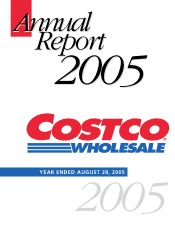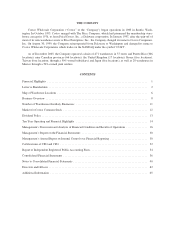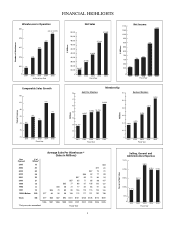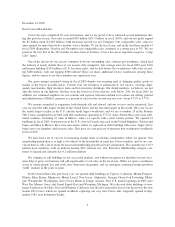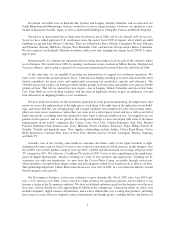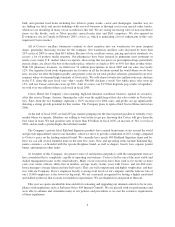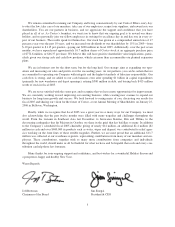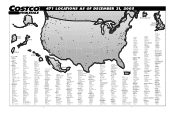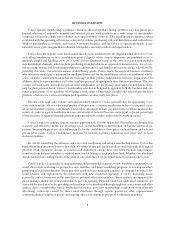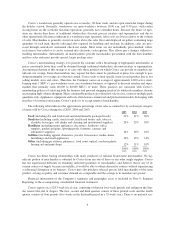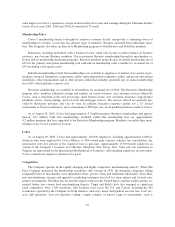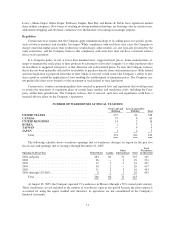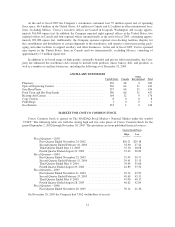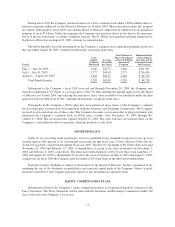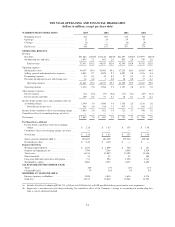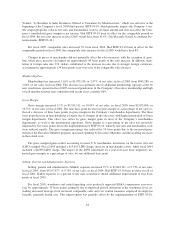Costco 2005 Annual Report Download - page 9
Download and view the complete annual report
Please find page 9 of the 2005 Costco annual report below. You can navigate through the pages in the report by either clicking on the pages listed below, or by using the keyword search tool below to find specific information within the annual report.BUSINESS OVERVIEW
Costco operates membership warehouses based on the concept that offering members very low prices on a
limited selection of nationally branded and selected private label products in a wide range of merchandise
categories will produce high sales volumes and rapid inventory turnover. This rapid inventory turnover, when
combined with the operating efficiencies achieved by volume purchasing, efficient distribution and reduced han-
dling of merchandise in no-frills, self-service warehouse facilities, enables Costco to operate profitably at sig-
nificantly lower gross margins than traditional wholesalers, discount retailers and supermarkets.
Costco buys the majority of its merchandise directly from manufacturers for shipment either directly to Cost-
co’s selling warehouses or to a consolidation point (“depot”) where various shipments are combined so as to
minimize freight and handling costs. As a result, Costco eliminates many of the costs associated with multiple
step distribution channels, which include purchasing from distributors as opposed to manufacturers, use of cen-
tral receiving, storing and distributing warehouses, and storage of merchandise in locations off the sales floor. By
providing this more cost-effective means of distributing goods, Costco meets the needs of business customers
who otherwise would pay a premium for small purchases and for the distribution services of traditional whole-
salers, and who cannot otherwise obtain the full range of their product requirements from any single source. In
addition, these business members will often combine personal shopping with their business purchases. The cost
savings on brand name and selected private label merchandise are the primary motivation for individuals shop-
ping for their personal needs. Costco’s merchandise selection is designed to appeal to both the business and con-
sumer requirements of its members by offering a wide range of nationally branded and selected private label
products, often in case, carton or multiple-pack quantities, at attractively low prices.
Because of its high sales volume and rapid inventory turnover, Costco generally has the opportunity to re-
ceive cash from the sale of a substantial portion of its inventory at mature warehouses before it is required to pay
all its merchandise vendors, even though Costco takes advantage of early payment terms to obtain payment dis-
counts. As sales in a given warehouse increase and inventory turnover becomes more rapid, a greater percentage
of the inventory is financed through payment terms provided by vendors rather than by working capital.
Costco’s typical warehouse format averages approximately 139,000 square feet. Floor plans are designed for
economy and efficiency in the use of selling space, in the handling of merchandise and in the control of in-
ventory. Because shoppers are attracted principally by the availability of low prices on brand name and selected
private label goods, Costco’s warehouses need not be located on prime commercial real estate sites or have
elaborate facilities.
By strictly controlling the entrances and exits of its warehouses and using a membership format, Costco has
been able to limit inventory losses to less than two-tenths of one percent of net sales—well below those of typical
discount retail operations. Losses associated with dishonored checks have also been minimal and bank in-
formation from business members is verified prior to establishing a check purchase limit. Members are identified
and prevented from cashing checks at the point of sale when they have presented dishonored checks to Costco.
Costco’s policy is generally to limit marketing and promotional expenses to new warehouse openings, occa-
sional direct mail marketing to prospective new members and direct marketing programs to existing members
promoting selected merchandise. These practices result in lower marketing expenses as compared to typical dis-
count retailers and supermarkets. In connection with new warehouse openings, Costco’s marketing teams
personally contact businesses in the area that are potential wholesale members. These contacts are supported by
direct mailings during the period immediately prior to opening. Potential Gold Star (individual) members are
contacted by direct mail or by providing such mailings to be distributed through employee associations and other
entities. After a membership base is established in an area, most new memberships result from word-of-mouth
advertising, follow-up contact by direct mail distributed through regular payroll or other organizational
communications to employee groups and ongoing direct solicitations to prospective wholesale members.
8

